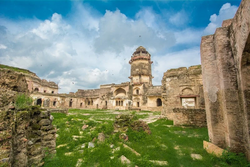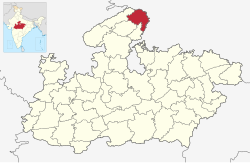Bhind district
Bhind District (Hindi pronunciation: [bʱɪɳɖ]) is a district in the Chambal division of the Indian state of Madhya Pradesh. HistoryThe region was originally held by the Bhadauria Rajputs (a branch of the Chahamanas of Shakambhari) for twenty-two generations. Bhind as a town was firstly established by the Maharaja of Bhadawar, Badan Singh Devju in the 16th century on the name of his spiritual master, Bhindi Rishi.[1] The town firstly suffered pillage during the raid of Marathas under Bajirao I in 1737 A.D. Later in 1796 A.D., it was invaded by a Maratha general, Pragdas under Daulat Rao Sindhia of Gwalior State. The Raja of Bhadawar had to retire from his capital to Nowgawan.[2] Historical Places of Bhind
GeographyBhind is surrounded by Agra, Etawah, Jalaun and Jhansi districts of Uttar Pradesh state to the north and the east, and the Madhya Pradesh districts of Datia to the south, Gwalior to the southwest, and Morena to the west. The geography of the district is characterised by uneven ravines, plain fertile fields and scanty forests. The total area of the district is 4,459 km2 (1,722 sq mi). Bhind's soil is drained by the Chambal, Sindh, Kunwari or Kwari, Pahuj and Baisali rivers aided by an extensive canal system. Demographics
According to the 2011 census Bhind District had a population of 1,703,005,[7] roughly equal to the nation of The Gambia[8] or the US state of Nebraska.[9] This gives it a ranking of 286th in India (out of a total of 640).[7] The district has a population density of 382 inhabitants per square kilometre (990/sq mi).[7] Its population growth rate over the decade 2001-2011 was 19.25%.[7] Bhind has a sex ratio of 837 females for every 1000 males,[7] and a literacy rate of 64.29%. 25.42% of the population lives in urban areas. Scheduled Castes and Scheduled Tribes make up 22.01% and 0.36% of the population respectively.[7] Hindi is the predominant language, spoken by 99.59% of the population.[10] The dominant castes of Bhind are Gadariya, Rajput, Brahmin, Soni, Kushwaha, Kayastha, and Jain with sizeable number of Lodhis and Yadavs.[11] AdministrationBhind district administration is headed by the District Magistrate of Bhind. The DM is assisted by a Chief Executive Officer (CEO), Additional District Magistrates (ADM) and two Joint Collector. The district is divided into 5 sub-divisions and 6 development blocks. Each sub-division headed by a Sub Divisional magistrate. It is further divided into 10 tehsils.
Tourist attractionsChhatri of Malhar Rao Holkar, AlampurMaharani Ahilyabai Holkar built the chhatri of Malhar Rao Holkar at Alampur in Bhind district in 1766. It is marked by carvings. It is built on the pattern of the chhatris of Holkar rulers at Indore.[7] Shri Rawatpura DhamThe temple of Hindu Lord Hanuman is situated at Lahar tehsil of Bhind. This place is known as Rawatpura Dham and is under in Lahar tehsil.[12] Fort of AterAter Fort was built by king Badan Singh Bhadauria from 1664 to 1668. The Fort of Ater is located near Ater town, 35 km (22 mi) from Bhind and 40 km (25 mi) from Porsa Morena.[13][14] National Chambal (Gharial) Wildlife SanctuaryNational Chambal (Gharial) Wildlife Sanctuary is situated on the Chambal River, and is inhabited by crocodiles, ghariyals, Ganges dolphins, and migratory birds. A boat cruise is organised by local forest officials. The sanctuary is 22 kilometres (14 mi) from Bhind town.[15] Gohad FortGohad Fort was built by the Bamraulia Jat ruler Singhandev II in 1505. Government offices are currently situated on its premises.[16] Ancient Dandraua Temple Mehgaon TehsilThis is a temple to the Hindu God Hanuman, believed to possess curing powers. Worshipers go to the temple every Tuesday and Saturday. Another Panchmukhi Hanuman mandir in Heerapura 10 km (6.2 mi) from Lahar.[17] Notable personalities
Villages
References
External linksWikimedia Commons has media related to Bhind district. |
||||||||||||||||||||||||||||||||||||||||||||||||||||||||||||||||||||||||||||||||||||||||||||||||||||||||||||||||||||||||
Portal di Ensiklopedia Dunia















